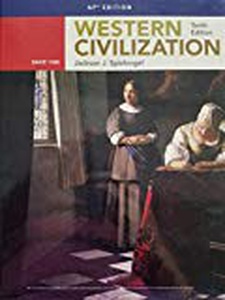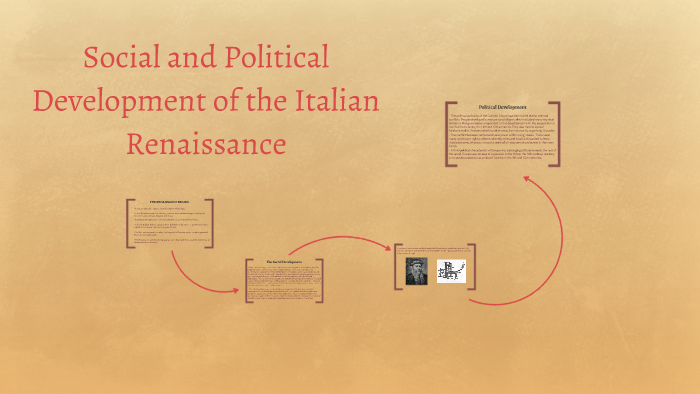In Renaissance Italy, the pattern of political development was complex and dynamic, shaped by the interplay of various city-states and ruling families. One intriguing aspect was the fragmentation of power, with multiple independent states vying for control. This fostered a competitive environment that fueled artistic and intellectual advancements, but also sparked conflicts and instability.
At the heart of political development in Renaissance Italy was the concept of city-state governance. Prominent families such as the Medici in Florence and the Sforza in Milan played pivotal roles in shaping these states. Additionally, the Italian peninsula saw the emergence of republics like Venice and Genoa that advocated for civic participation. However, the patronage system, where powerful families sponsored art and culture, also exerted influence over political affairs.
The pattern of political development in Renaissance Italy was characterized by a shift from feudalism to city-states. As a result of the decline of the feudal system, wealthy merchants and powerful families gained control over the cities, leading to the rise of independent city-states like Florence, Venice, and Milan. These city-states were often ruled by oligarchies or powerful families who competed for political power. The political landscape was also marked by constant power struggles, alliances, and conflicts between the city-states.

Contents
- The Political Landscape of Renaissance Italy
- The Pattern of Political Development in Renaissance Italy
- Key Takeaways
- Frequently Asked Questions
- 1. How were city-states governed in Renaissance Italy?
- 2. How did ruling families gain and maintain power in Renaissance Italy?
- 3. How did foreign powers influence political development in Renaissance Italy?
- 4. What impact did the Church have on political development in Renaissance Italy?
- 5. How did the pattern of political development in Renaissance Italy impact the social and economic life of its citizens?
The Political Landscape of Renaissance Italy
Renaissance Italy was characterized by a complex and diverse political landscape. The period from the 14th to the 16th centuries saw the rise of powerful city-states, each with its unique form of government and ruling elite. The pattern of political development in Renaissance Italy was shaped by a combination of factors, including the legacy of feudalism, the influence of the Catholic Church, and the rise of wealthy merchant families. Understanding the political dynamics of this era is crucial for gaining insights into the cultural and intellectual achievements of the Renaissance.
City-States: The Centers of Power
One of the most defining features of Renaissance Italy was the existence of city-states, independent urban centers that held significant power and authority. These city-states, such as Florence, Venice, and Milan, were not only centers of commerce and trade but also became cultural and artistic hubs. Each city-state had its own political structure, which varied widely across different regions.
In Florence, for example, power was concentrated in the hands of a small group of wealthy families, known as the oligarchy. The Medici family, in particular, played a prominent role in the political and cultural life of Florence, with several members serving as influential political leaders and patrons of the arts. Venice, on the other hand, operated as a republic, with power shared among a larger group of aristocrats who were elected to serve in the government. Milan, under the Visconti and Sforza families, was ruled as a hereditary monarchy.
Despite their differences in governance, city-states shared certain characteristics. They were fiercely independent and often engaged in conflicts, both political and military, with one another to expand their territories and assert dominance. These rivalries and power struggles between city-states were a central feature of Renaissance politics, shaping the course of Italian history during this period.
The city-states of Renaissance Italy were also heavily influenced by the Catholic Church, which held significant power and influence over religious and political affairs. The Church played a pivotal role in the appointment of bishops and other religious leaders, and its financial wealth allowed it to assert authority over secular rulers. This influence was particularly evident in the Papal States, a region in central Italy directly controlled by the Pope, who held both religious and temporal authority.
Commerce and the Rise of the Merchant Elite
Another key aspect of the political development in Renaissance Italy was the rise of wealthy merchant families. As trade and commerce flourished during this period, a new class of merchants emerged, accumulating vast wealth and becoming influential figures in society. These merchant families, such as the Medici in Florence and the Fugger in Augsburg, played a significant role in shaping the political landscape.
In many city-states, these merchant families leveraged their economic power to gain political influence. They often held key positions in the government and used their wealth to sponsor cultural and artistic endeavors. This patronage of the arts was a hallmark of the Renaissance, with wealthy families commissioning renowned artists and architects to create masterpieces that celebrated their wealth and status.
At the same time, the influence of the merchant elite was not without its challenges. Traditional aristocratic families, who had inherited their wealth and status, often resented the growing power of the merchant class. This tension between the old nobility and the rising merchant elite contributed to the political dynamics of Renaissance Italy, with rivalries and alliances forming along class lines.
Overall, the pattern of political development in Renaissance Italy was characterized by a fragmented and constantly shifting power structure. City-states, with their unique governance systems and ruling elites, vied for dominance and engaged in conflicts with one another. The influence of the Catholic Church and the rise of wealthy merchant families added further complexity to the political landscape. Understanding these dynamics provides valuable insights into the societal and cultural achievements of the Renaissance.

The Pattern of Political Development in Renaissance Italy
In Renaissance Italy, the pattern of political development was characterized by the fragmentation of power and the rise of city-states. This period, spanning from the 14th to the 16th century, saw Italy divided into multiple independent and often rivaling city-states, such as Florence, Venice, and Milan. Each city-state had its own government and ruling elite, shaping the political landscape of the time.
One key feature of political development during the Renaissance was the emergence of powerful ruling families, known as the Italian Renaissance oligarchy. These families gained control over their respective city-states through a combination of wealth, political alliances, and strategic marriages. Notable examples include the Medici in Florence and the Visconti and Sforza families in Milan.
The city-states of Renaissance Italy also had different forms of government, ranging from republics, such as Florence, to oligarchies, like Venice. Additionally, the influence of the Catholic Church played a significant role in shaping political power. The Papal States, under the authority of the Pope, controlled significant territories in central Italy and exerted religious and political influence over the city-states.
Overall, the pattern of political development in Renaissance Italy was marked by fragmented power, the rise of ruling families, and various forms of government. This complex political landscape contributed to the cultural and artistic flourishing of the time, as city-states competed for power and patronage, fostering the renowned Renaissance achievements in art, literature, and science.
Key Takeaways
- The political development in Renaissance Italy followed a pattern of city-states and independent governments.
- The Italian city-states were ruled by wealthy elites, known as oligarchs.
- The oligarchs often engaged in power struggles and rivalries, leading to frequent conflicts.
- Medici family played a significant role in the political landscape of Renaissance Italy.
- The city-states of Renaissance Italy eventually fell under the control of powerful external forces.
Frequently Asked Questions
In Renaissance Italy, the pattern of political development was marked by a complex interplay between city-states, ruling families, and foreign powers. Here are some frequently asked questions about the political landscape of Renaissance Italy:
1. How were city-states governed in Renaissance Italy?
In Renaissance Italy, city-states were governed by different political systems. Some city-states, like Florence, were ruled by oligarchies or republics. These governments were characterized by the rule of a small group of wealthy families or elected officials. Other city-states, like Venice, were ruled by aristocratic oligarchies.
Meanwhile, some city-states, like Milan and Naples, were ruled by powerful hereditary rulers known as despots. These rulers had absolute power and often relied on the support of the military and foreign powers to maintain their rule.
2. How did ruling families gain and maintain power in Renaissance Italy?
Ruling families in Renaissance Italy gained and maintained power through a combination of political alliances, economic influence, and military strength. These families, such as the Medici in Florence and the Sforza in Milan, often used their wealth and patronage of the arts to gain popularity and secure their rule.
Sometimes, these ruling families would form alliances with other powerful families to strengthen their position. However, these alliances were often fragile and could quickly dissolve if the balance of power shifted.
3. How did foreign powers influence political development in Renaissance Italy?
Foreign powers played a significant role in the political development of Renaissance Italy. They often sought to gain control over Italian city-states for strategic or economic reasons. Powerful foreign powers, such as France and Spain, would intervene in Italian politics and support different factions or ruling families to further their own interests.
These foreign interventions often led to conflicts and power struggles within Italy, as city-states and ruling families aligned themselves with different foreign powers to secure their own survival. The constant interference from foreign powers ultimately weakened the independence and unity of Renaissance Italy.
4. What impact did the Church have on political development in Renaissance Italy?
The Church, particularly the Papacy, had a significant influence on political development in Renaissance Italy. Popes often wielded both spiritual and temporal power and sought to assert their authority over the city-states. They would often intervene in political affairs, appoint rulers, and use their influence to shape the political landscape.
The Church’s involvement in politics sometimes led to conflicts, as ruling families and city-states resisted Papal interference in their affairs. However, the Church also provided stability and moral guidance during a time of political uncertainty, and its patronage of the arts played a crucial role in the cultural development of Renaissance Italy.
The pattern of political development in Renaissance Italy had a profound impact on the social and economic life of its citizens. The constant power struggles and shifting alliances created an environment of uncertainty and insecurity, particularly for the common people.
Economic prosperity often depended on having strong political connections, and those without such connections struggled to thrive. The ruling families and the wealthy elite enjoyed privileged positions and controlled the majority of economic resources.
In Renaissance Italy, the pattern of political development was characterized by city-states and rival factions vying for power.
These city-states, such as Florence, Venice, and Milan, had their own unique political systems and ruling families, often governed by oligarchic or republican structures.
The political landscape was marked by constant power struggles, alliances, and conflicts between these city-states, as well as the influence of external forces such as foreign powers and the Catholic Church.
The Medici family in Florence, for example, became one of the most influential patrons of the arts and wielded significant political power, while the Papal States were controlled by the Pope.
This complex and dynamic political environment fostered competition, innovation, and cultural exchange, leading to the flourishing of the arts, sciences, and humanities during the Renaissance.
Overall, the pattern of political development in Renaissance Italy was characterized by a decentralized system of city-states, diverse political structures, and constant power struggles, ultimately shaping the cultural and intellectual achievements of the time.